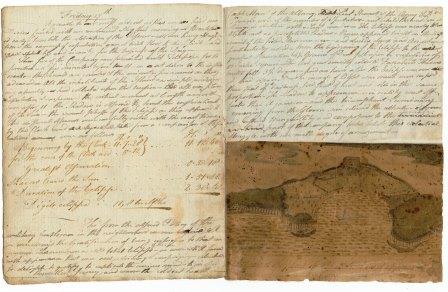By
On Monday, 21 August 2017, a solar eclipse will occur! Many people in Boston are looking forward to 2:46 pm when they will (weather permitting!) experience what it is like when the sun is about 60% eclipsed.
Staff of the MHS have located a few items that convey descriptions of other solar eclipses. Please enjoy this sampler (arranged in reverse chronological order):
1878
A description and illustration of the eclipse that was visible 29 July 1878 from Snake River Pass, Colorado appeared in Harper’s Weekly.
At 3 hours 12 minutes 0 seconds the great orb looked only like the newest of new moons, and the wonderful light over all the grand landscape was not of sunlight, or moonlight, or starlight, or twilight, and an adequate description, beyond stating the tint as a peculiar lilac, is impossible.
During totality the sharp breeze sweeping over the elevated ridges became so intensely cold that we actually suffered, and the re-appearance of the sun was hailed with pleasure.1

“The Great Solar Eclipse.” Engraving from Harper’s Weekly, 24 August 1878. Vol. XXII, Number 1130, page 673.
1831
Charles Francis Adams wrote about the eclipse he witnessed in Boston on 12 February 1831.
But as there must always be something or other to distract my attention, so today it was taken off by the eclipse of the Sun which took place about noon. I spent some time in observing this phenomenon. The Sun was not entirely darkened as the eclipse was not total, consequently the light was but partially affected. The cold however was considerable, and the temperature did not recover it throughout the day. The sight is a splendid one…. Every body was looking and little was done. The appearance of the Streets was certainly curious. Men, Women and Boys all gazing at a spectacle the nature of which there were not many to comprehend.2
1780
John Davis (1761-1847) describes the total solar eclipse that happened on 27 October 1780. Davis was part of an expedition led by Samuel Williams that was so motivated to observe the eclipse they traveled to a part of Maine that was under the control of the British army. Only a fragment of his Davis’s diary survives.
Five of the company were furnished with telescopes for observation. A few minutes before 11, we sit down to the instruments. The seconds are counted & the minutes pronounced as they advanced….All [was]…expectation and suspense–the initial moment at length arrives, & soon after 11, the shadow is observed to touch the western limb of the sun. The several phases of the eclipse as they appeared to the different observers were carefully noted…
The eclipse was nearly total. Objects cast no perceptible shadow. Venus appeared bright in the west.3

1766
The eclipse of 5 August 1766 is described in a newspaper. A Boston newspaper published on 11 August 1766 includes a short piece about the eclipse. As was common at the time, newspapers would republish news from other locations, and the heading on the piece about the eclipse is: “Portsmouth. August, 8.”
Last Tuesday being fair Weather and very Hot we had a distinct View of the remarkable ECLIPSE of the SUN–At the Time of greatest Observation, it appeared larger than is represented in the Almanack–the Air was considerably darkned, so that some who did not know of the Eclipse, were surprised.4
*****
1. “The Great Solar Eclipse,” by St. George Stanley. Harper’s Weekly, 24 August 1878. Vol. XXII, Number 1130, page 675.
2. From Charles Francis Adams diary, 12 February 1831. The transcribed entry is available online as part of the Adams Papers Digital Editions: http://www.masshist.org/publications/apde2/view?id=ADMS-13-03-02-0003-0002-0012
3. From John Davis diary, 1780. From the collection of the Massachusetts Historical Society.
4. From: The Boston Gazette, and Country Journal, 11 August 1766 supplement. Online version is available within The Annotated Newspapers of Harbottle Dorr, Jr.: http://www.masshist.org/dorr/volume/1/sequence/480 (see column 1)

